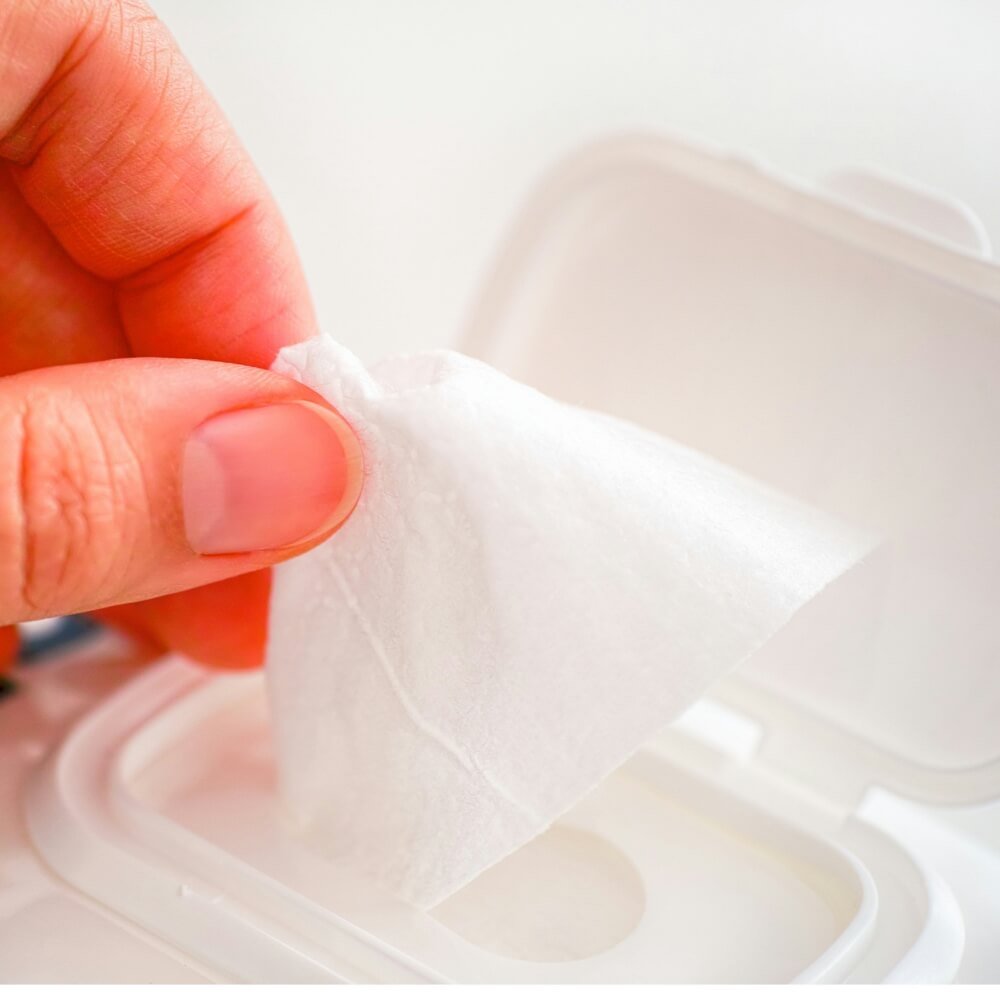No mundo eco-consciente de hoje, é crucial compreender os rótulos dos produtos que utilizamos diariamente, como os toalhetes. Os toalhetes biodegradáveis e compostáveis são apresentados como alternativas amigas do ambiente aos toalhetes tradicionais, mas o que significa realmente cada rótulo? Este artigo analisa as definições, diferenças e impactos ambientais dos toalhetes biodegradáveis e compostáveis, fornecendo-lhe as informações necessárias para fazer escolhas informadas e sustentáveis.
Compreender os toalhetes biodegradáveis
Os toalhetes biodegradáveis são concebidos para se decomporem naturalmente com a ajuda de bactérias e fungos. Ao contrário dos toalhetes normais, que podem demorar décadas a decompor-se, os toalhetes biodegradáveis decompõem-se normalmente no espaço de vários anos, nas condições ambientais corretas. No entanto, o termo "biodegradável" pode ser enganador, uma vez que não existe uma regulamentação rigorosa sobre a rapidez com que estes produtos se devem decompor. Os consumidores devem procurar informações específicas sobre a composição do toalhete e as condições ambientais necessárias para uma decomposição adequada.
Como se decompõem os toalhetes biodegradáveis
Os toalhetes biodegradáveis requerem condições específicas para se decomporem, como a presença de microorganismos, humidade e, por vezes, oxigénio. O processo de decomposição converte os toalhetes em dióxido de carbono, água e biomassa. No entanto, se forem eliminados num ambiente anaeróbico como um aterro, onde o oxigénio é escasso, mesmo os toalhetes biodegradáveis podem persistir durante muito tempo. Por conseguinte, compreender a via de eliminação é tão importante como a natureza biodegradável do toalhete.
Compreender os toalhetes compostáveis
Os toalhetes compostáveis são um passo em frente em termos de responsabilidade ambiental. Estes toalhetes não só se decompõem como o fazem de uma forma que contribui positivamente para o composto, transformando-se em húmus rico em nutrientes. A distinção aqui é que os toalhetes compostáveis devem cumprir determinadas normas, como a ASTM D6400 nos Estados Unidos, que exigem que o produto se decomponha numa instalação de compostagem dentro de um prazo específico, normalmente 90 dias.
Como se decompõem os toalhetes compostáveis
Os toalhetes compostáveis decompõem-se nas condições das instalações industriais de compostagem, que fornecem a atividade microbiana, o calor e a humidade necessários para garantir uma decomposição completa. Uma vez decompostos, estes toalhetes não deixam resíduos nocivos, contribuindo antes para a criação de composto que pode ajudar a melhorar a saúde do solo. Esta caraterística faz com que os toalhetes compostáveis não sejam apenas uma escolha ecológica, mas também uma escolha proactiva que contribui para a sustentabilidade ambiental.
Principais diferenças entre toalhetes biodegradáveis e compostáveis
A principal diferença entre toalhetes biodegradáveis e compostáveis reside no seu impacto ambiental e nas condições específicas em que se decompõem. Enquanto os toalhetes biodegradáveis se degradam ao longo do tempo em compostos mais simples, os toalhetes compostáveis fazem-no de forma mais eficiente e produzem um produto benéfico para a terra. Além disso, as normas regulamentares para os toalhetes compostáveis são mais rigorosas, garantindo que oferecem um benefício tangível para o processo de compostagem e, em última análise, para a saúde do solo.
Processo de decomposição
O processo de decomposição de cada tipo de toalhetes é regido por factores diferentes. Os toalhetes biodegradáveis requerem frequentemente períodos mais longos e condições específicas, que não são garantidos em cenários de eliminação típicos, como os aterros sanitários. Por outro lado, os toalhetes compostáveis são concebidos para se decomporem num ambiente controlado num período de tempo relativamente curto, com a garantia de que se transformam em composto útil sem deixar resíduos tóxicos.
Impacto ambiental
Os toalhetes compostáveis têm geralmente um menor impacto ambiental em comparação com os biodegradáveis, especialmente quando eliminados corretamente em instalações de compostagem. Apoiam a economia circular, devolvendo nutrientes valiosos ao solo. No entanto, a vantagem ambiental dos toalhetes compostáveis depende da disponibilidade de instalações de compostagem locais, o que pode limitar a sua eficácia se essas instalações não existirem.
Métodos de eliminação adequados
Compreender os métodos de eliminação adequados para cada tipo de toalhetes é essencial para maximizar os seus benefícios ambientais. Idealmente, os toalhetes biodegradáveis devem ser eliminados em condições que facilitem a decomposição aeróbica, como um aterro bem gerido que revolve regularmente os resíduos. No entanto, isto nem sempre é garantido. Os toalhetes compostáveis, pelo contrário, devem ser eliminados numa instalação de compostagem que cumpra as normas necessárias para garantir que se decompõem corretamente e contribuem para o composto. É fundamental que os consumidores conheçam as suas infra-estruturas locais de gestão de resíduos para fazerem a melhor escolha.
O impacto no ambiente
Os efeitos a longo prazo das toalhitas biodegradáveis e compostáveis no ambiente dependem significativamente do comportamento dos consumidores e das práticas locais de gestão de resíduos. Aqui, exploramos a forma como cada tipo de toalhetes tem impacto nos ecossistemas e o que isso significa para o nosso planeta.
Efeitos dos toalhetes biodegradáveis nos ecossistemas
Embora os toalhetes biodegradáveis ofereçam uma redução da persistência em comparação com as opções não degradáveis, o seu impacto nos ecossistemas pode ainda ser significativo. A eliminação incorrecta pode levar a que os toalhetes se acumulem em ambientes como os oceanos ou outras massas de água, onde representam uma ameaça para a vida selvagem e os ecossistemas. Embora acabem por se decompor, o processo pode ser lento e libertar metano, um potente gás com efeito de estufa, se ocorrer num ambiente anaeróbico.
Efeitos dos toalhetes compostáveis nos ecossistemas
Os toalhetes compostáveis foram concebidos para minimizar o impacto ambiental, desde que sejam eliminados corretamente. Quando integrados em processos de compostagem industrial, estes toalhetes contribuem para a produção de composto rico em nutrientes que beneficia as terras agrícolas e reduz a necessidade de fertilizantes químicos. No entanto, se os toalhetes compostáveis não forem eliminados no local correto, também eles podem contribuir para a poluição e a degradação ambiental.
Orientação do consumidor
Fazer escolhas informadas sobre o tipo de toalhetes a utilizar pode ter um impacto significativo na sustentabilidade ambiental. Eis como os consumidores podem navegar pelas suas opções.
Como escolher os toalhetes certos
Os consumidores devem ter em conta os rótulos dos produtos e as capacidades locais de eliminação quando escolhem toalhetes. Se a sua comunidade local tiver acesso a instalações industriais de compostagem, os toalhetes compostáveis são a opção preferível. Para aqueles que não têm esse acesso, os toalhetes biodegradáveis são uma melhor escolha do que as alternativas não degradáveis, embora os benefícios ambientais sejam menos pronunciados.
O que procurar nos rótulos
Os rótulos podem muitas vezes ser confusos ou mesmo enganadores. Procure certificações específicas como o Biodegradable Products Institute (BPI) para os toalhetes biodegradáveis ou a TUV Austria (OK Compost) para os compostáveis. Estas certificações garantem que os toalhetes cumprem normas ambientais rigorosas e oferecem transparência sobre o impacto real do produto.
Normas e certificações do sector
As normas e certificações desempenham um papel crucial na garantia de que as alegações ambientais sobre toalhetes são válidas e verificáveis. A sua compreensão pode ajudar os consumidores a fazerem escolhas mais responsáveis do ponto de vista ambiental.
Visão geral das certificações relevantes
Certificações como a ASTM D6400 (para produtos compostáveis nos EUA) e a EN 13432 (na Europa) são cruciais para verificar a compostabilidade dos toalhetes. Estas normas garantem que os produtos são capazes de se decompor numa instalação de compostagem sem deixar resíduos nocivos. Para produtos biodegradáveis, certificações como a ASTM D5338 (para biodegradação aeróbica) fornecem garantias semelhantes.
Como as certificações influenciam a qualidade do produto
Os produtos que cumprem estas normas rigorosas são geralmente de maior qualidade em termos de sustentabilidade ambiental. As certificações garantem que os produtos têm o desempenho esperado em condições reais, dando garantias aos consumidores preocupados com o ambiente.
Aplicação no mundo real e estudos de caso
A análise de aplicações reais e de estudos de casos de toalhetes biodegradáveis e compostáveis pode fornecer informações sobre os seus impactos e benefícios práticos.
Estudos de caso de implementações bem-sucedidas
Estudos de caso de todo o mundo mostram os benefícios da utilização de toalhetes compostáveis e biodegradáveis. Por exemplo, uma cidade na Suécia conseguiu passar a utilizar toalhetes compostáveis nos serviços de limpeza municipais, reduzindo significativamente os resíduos depositados em aterros e melhorando a qualidade do composto local.
Lições aprendidas em diferentes regiões
As diferentes regiões oferecem lições valiosas sobre a implementação de toalhetes ecológicos. Em zonas com instalações de compostagem robustas, os toalhetes compostáveis demonstraram um claro benefício ambiental. Inversamente, as regiões que não dispõem destas instalações obtiveram benefícios limitados com os toalhetes biodegradáveis devido a práticas de eliminação inadequadas.
A passagem dos toalhetes convencionais para alternativas mais sustentáveis, como os toalhetes biodegradáveis e compostáveis, representa um passo significativo na redução da nossa pegada ambiental. Ao compreender as principais diferenças e impactos de cada tipo, os consumidores podem fazer escolhas informadas que se alinham com a sua infraestrutura ambiental local e valores pessoais.
A escolha do tipo correto de toalhetes - biodegradáveis ou compostáveis - requer não só uma compreensão das propriedades do produto, mas também uma consideração das opções de eliminação locais. Para quem vive em regiões com instalações de compostagem acessíveis, os toalhetes compostáveis oferecem uma solução robusta que apoia uma economia circular ao devolver nutrientes valiosos ao solo. Entretanto, para as áreas sem essas instalações, os toalhetes biodegradáveis constituem uma alternativa preferível às opções não degradáveis, embora com menos benefícios ambientais se não forem geridos corretamente.

